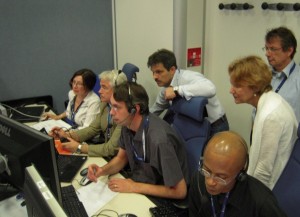Diary from a space project 3 May, Thursday, L+42
An update from ESA’s Charlotte Beskow, deputy ATV team head, from Toulouse, reporting on activities on Thursday and Friday, 3-4 May, to troubleshoot the electrical system connecting ATV to the ISS – Ed.
Thursday, 3 May

RSCE experts have arrived in Toulouse for this attempt, Galina and Andrei and Yuri are gazing at the screens showing the RECS TM. . We also have our own experts, Gildas (Bremen) and Philippe (Les Mureaux) as well as Regina and Jacques (our formal interface to the RSCE experts). Other experts (vehicle behaviour, computer data, power and thermal) are present in the room (but not in the picture) Credit: ESA/C. Beskow
The Flight Control Team (FCT) and the Engineering Support Team (EST) had been preparing for this day ever since we lost a part of the equipment that interfaces the Russian Systems (RICU11) on 30 March.
[Editor’s note: On 30 March, the command path to one of four RICU units (part of the ATV-to-ISS electrical interface) failed. Later, a second back-up chain was successfully switched on to take over the lost command path and the ATV-to-ISS power bus connection was restored 31 March. Details here.]
At the time the incident happened, the vehicle reacted correctly, i.e., it switched off the suspect equipment and reconfigured the power connection to use another chain. This allowed us to continue our planned, nominal operations with ATV-3 docked to the ISS.
Over Easter and during the following weeks, engineering teams were busy analysing data to see what had happened. This was done in close cooperation with our Russian colleagues.
As you might understand, it is not so simple to discuss technically complicated equipment via telephone with engineers and technicians located at at least four participating sites across Europe — ESA/ESTEC in NL, ATV-CC in Toulouse; Les Mureaux, near Paris; and RSC Energia, in Russia.
This work was complemented by testing at various sites and the test results were fed into the overall analysis.
The analysis eventually concluded with a recommendation to switch ON the suspect equipment (hoping to see if the initial alarm had been caused by a temporary ‘transient’ condition), verify its behaviour and then switch it OFF again, and then use data recorded during this exercise to conduct an overnight analysis. If the analysis was positive (that is, if the experts were confident that we could attempt a reintegration of the RICU11 into the nominal power chain), then we would perform that task the following day (Friday, 4 May).
The necessary procedures were developed, validated on a testing facility, and then delivered to ATV-CC for implementation.
A suitable date free from other ISS activities such as Progress undocking , Progress docking, Soyuz undocking, reboost, &etc., was found (believe me this is not as easy as it sounds!); we settled on Thursday, 3 May, for the activation / deactivation/ analysis, and Friday, 4 May, for the activation / reintegration into nominal chain.
RSC Energia experts, knowledgeable on this particular equipment, arrived at ATV-CC Toulouse on 2 May. Their expertise would be required for the analysis. ESA’s Engineering Support Team experts also arrived on 2 May; we were all looking forward to this and keeping our fingers crossed for a successful outcome.
RICU 11 was switched on in the morning of 3 May. The data obtained during this were ambiguous and showed instabilities. It was decided to switch OFF and then switch ON the equipment again. This second try settled the matter, at least for the foreseeable future: it was quickly determined that the equipment was not healthy. Therefore, the rest of the plan — to reintegrate the chain back into regular use — had to be scrapped.
ATV-3 continues on its nominal mission using Chain 2, the back-up interface chain, with the ISS. It was in this configuration that ATV-3 performed reboost No. 2 of the ISS on 4 May.
The engineering teams will remain here in Toulouse and will spend Friday, 4 May, on data analysis. This will continue tomorrow, Saturday, 5 May — perhaps not our favourite plan for a weekend, but the company is great and the weather report in any case not promising!
That’s it for now… stay tuned!
— Charlotte
Editor’s note: For those with a techie bent, here are a few more details on the activity described by Charlotte above, via NASA’s daily Station update for 5 May.
Oleg Kononenko meanwhile had ~3.5 hrs for continuing the investigation of functionality & performance of the Russian POTOK Air Purification System of the SOGS Air Revitalization Subsystem which may have been involved in the 3/30 loss of RECS (Russian Equipment Control System) power feed from the SM to ATV-3. [Today’s activity focused on taking POTOK interference (noise) measurements using the electrical Scopemeter (measuring oscilloscope). ESA meanwhile has performed testing on the RECS1 RICU (Interface Control Unit) which converts signals and transfers data between the analog RECS data busses and the digital ATV 1553 bus, and has found it to be failed. ATV is currently operating on RECS2 which it has been on since the initial RECS1 failure.]

 Automated Transfer Vehicle page
Automated Transfer Vehicle page ATV blog archive
ATV blog archive
Discussion: one comment
Just goes to show, often the best course of action for a technical problem is, turn it off, then turn it back on again 🙂